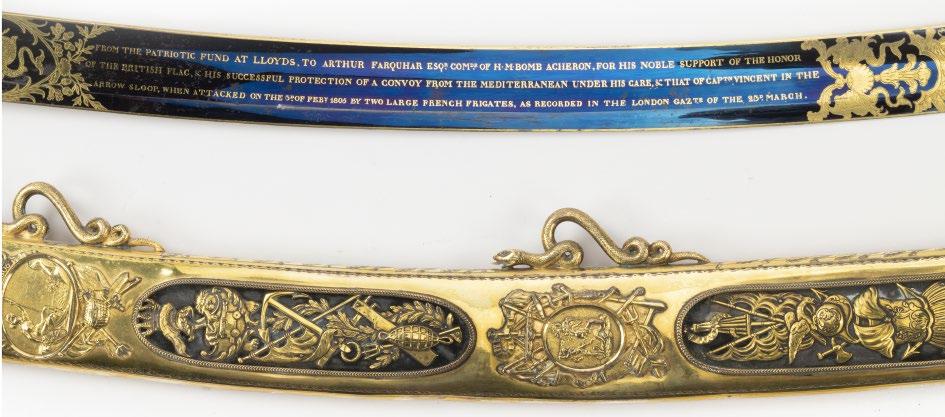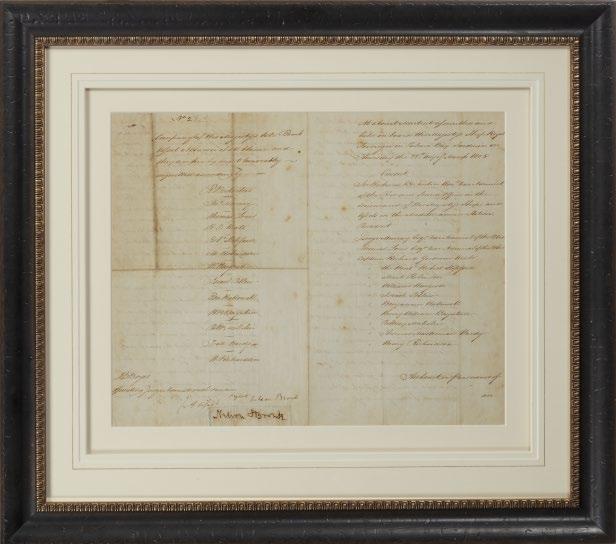
4 minute read
Commander Arthur Farquhar’s £100 Patriotic Fund sword
48 The Lloyd’s Patriotic Fund £100 sword awarded to Commander Arthur Farquhar under Admiral Viscount Nelson’s command in 1805.
Overall Length: 39in (99cm)
Advertisement
This £100 sword is inscribed in gilt on the heavily blued single-edged blade ‘From the Patriotic Fund at Lloyds, to Arthur Farquhar Esq Comdr of H M Bomb Acheron, for his noble support of the honor of the British flag & his successful protection of a convoy from the Mediterranean under his care, & that of Captn Vincent in the Arrow sloop, when attacked on the 3rd of Feb 1805 by two large French frigates as recorded in the London Gazette of the 13th March’. The reverse of the blade is profusely applied with gilt flowers, foliage, martial and naval trophies, mythical figures, cypher for King George III, the Royal Coat of Arms surmounted by a lion and crown, a phoenix and cherubs. The hilt consists of a diamond-knurled ivory grip, with the giltmetal pommel and back-piece in the form of a lion’s pelt. The quillon is in the form of a Roman fasces and the knuckle-guard is the club of Hercules entwined with a snake which attaches to a loop in the lion’s mouth. The langets are engraved with triangular floral pendants, below which is a rectangular plaque with a group in relief of a cannon, anchor, trident etc. The scabbard, also of ormolu, features cast and chased scenes set in medallions depicting Hercules in combat with the Hydra and the Nemean lion, in addition to a seated Britannia presenting a victor’s laurel crown before a representation of the battle. This medallion is surrounded by naval trophies and the stern of a British warship with “Acheron 1805” on the surround. Additional cast, pierced, and chased panels on faded blue velvet backing depict martial and naval trophies. The suspension loops are in the form of serpents. There is the maker’s name ‘R Teed sword cutler Lancaster Court Strand’ engraved around the inside of the scabbard. The Patriotic Fund was founded at a meeting in Lloyd’s Coffee House at the Royal Exchange, London, in 1803. It set up a national subscription used to vote money to those wounded in action, and to the dependants of those killed, and also gave awards of merit in the form of money, silver and presentation swords. Between 1804 and 1809 the fund awarded a total of 165 swords in three ranks, £100, £50 and £40 and 66 Patriotic Fund silver vases, designed by John Flaxman and supplied by royal goldsmiths, Rundell, Bridge and Rundell.


Arthur Farquhar (1772-1843) Commander of Acheron, lost his ship in the action for which he earned his Patriotic Fund sword but was acquitted of wrongdoing at his ensuing court martial where his actions were praised as ‘highly meritorious and deserving imitation’. As Farquhar was under Admiral Viscount Nelson’s command in the Mediterranean at the time, his court martial was attended and signed by several captains from the fleet who would subsequently gain fame at Trafalgar. Born in 1772, Farquhar joined the Navy at 15. He served as lieutenant on various ships until promoted to commander in 1802 and in January 1804 took command of Acheron. At dawn on the 3rd February 1805, in the company of the sloop Arrow, he was escorting a convoy of 35 merchant ships from Malta to England when two large ships were sighted. After a series of manoeuvres and signals the ships were identified as two French frigates, the Hortense, 40 guns, and Incorruptible, 38 guns. After an exchange of fire which considerably damaged Acheron’s rigging and sails, night fell. Dawn the following day saw the action continue and by 8.30 a.m. Arrow, which had been totally disabled, struck her colours to the Incorruptible, twenty minutes later the badly damaged Acheron hauled down her colours to the French warship Hortense. The action of these two greatly out-gunned and out-manned ships allowed all but three of the convoy to avoid capture and proceed safely to England. On the 8th April Farquhar was promoted to post-captain and later awarded this sword by the Patriotic Fund and a piece of plate by the Merchants of Malta. He continued to see active service in the Baltic and North Sea, capturing numerous privateers and commanded naval operations in the Weser, the Ems and the Elbe and at the capture of Glückstadt in 1814. For these services he was made a Knight of the Sword of Sweden and also of the Hanoverian Guelphic Order. In 1815 he was made a Commander of the Bath. From 1830 to 1833 he commanded Blanche, 48 guns, in the West Indies as Commodore and for his services there during the slave revolt received the thanks of the House of Assembly of Jamaica and a sword of £150 value. He was knighted on his return to England, attained the rank of Rear-Admiral in 1837 and died in 1843.
Opposite: Accompanying the sword is the original Court Martial signed by thirteen captains of the fleet and Admiral Lord Nelson. Water marks of a crowned Britannia medallion and Fellow 1805.


Framed Height: 18 in (46cm) Width: 20 in (51cm).










